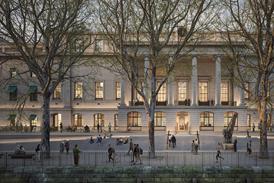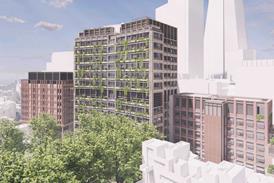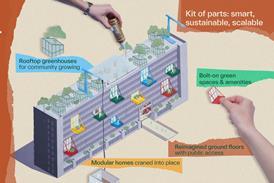Data is a useful tool but urban designers mustn’t overlook the importance of human intuition, says Amanda Baillieu

In a few weekends’ time, if all goes to plan, I’ll have walked 78 miles around inner London. This is the Capital Ring, not to be confused with the London Loop which is mainly in zone 6. Although my trusty guidebook says the Ring is a “green corridor” (and it does do a brilliant job linking canals, parks and woods), it is essentially an urban walk that winds around the capital via zones 2, 3 and 4.
I thought I knew my city pretty well but after 30 or so miles I have to admit I don’t. One of my discoveries is Oxleas Wood, part of a continuous belt of ancient woodland acquired by the London County Council during the 1920s and 30s. Despite having worked a mile or so away in Woolwich (when BD was headquartered there in the late 80s), I’d never visited.
Nor had I been back to Woolwich. When I did I found something had gone horribly wrong. It’s not simply the Tesco with hundreds of apartments piled on top that won BD’s Carbuncle Cup in 2014.
When I knew it, Woolwich was down-at-heel but now it seems to have lost its centre as investment has been ploughed into featureless residential towers on the river, splitting the town in two. If this is how London plans to grow, it’s frightening.
Walking, of course, is “slow travelling”: you notice much more. For every Woolwich or Woodberry Down – Berkeley Homes’ redevelopment of the massive Hackney council estate – there are delights to give you confidence. But the picture is patchy.
“You’ve got to get out and walk. Walk and you will see that many of the assumptions on which projects depend are visibly wrong,” wrote Jane Jacobs in 1958.
Activist, campaigner, thinker and writer, Jacobs’ ideas are familiar to most architects and while a new generation of urbanists prefer using data to solve urban problems, the human reasoning about cities that she promoted is still our best guide.
But this is what worries me about the layers of politicians, developers and architects charged with delivering housing numbers: that they have become so reliant on the data telling them what is needed to create “a vibrant, mixed community” that they are blind to the long horizon.
This, of course, is something Jacobs understood very well. Matt Tyrnauer’s new documentary, Citizen Jane: Battle for the City, is about her war with Robert Moses, New York’s planning director who wanted to replace the city’s slums with gleaming megastrutures and superhighways, but it was essentially a battle of ideas.
For Moses and his cronies, urban renewal was simple. You simply knocked down areas and rebuilt them without asking the people. (“They are only renters – just give them the cash and move them out,” he says about residents of Lower Manhattan whose homes were targeted for demolition.) And it’s an attitude not a million miles removed from selling off council estates to developers in return for some social housing, as has happened at Woodberry Down and many other estates across London.
Woodberry Down’s blandness, its tightly manicured lawns and designated play areas would have horrified Jacobs. But the battle lines have moved. London and New York are now the world’s most successful cities and the most difficult for people to get on the housing ladder: a one-bed flat on the former estate will cost almost £500,000 when it’s completed at the end of this year.
But she would have had something to say, some observations and some ideas about what is “good growth” – the new slogan emanating from City Hall – and what is bad.
Writing to applicants hoping to become one of his “design advocates”, London mayor Sadiq Khan reminds them that the capital is well on its way to becoming Europe’s first “megacity”, which is placing “pressure on our cherished neighbourhoods”.
These are the same concerns that Jacobs had when Moses started his urban renewal in 1950s New York, or what James Baldwin in the documentary calls “negro removal”.
Over the next few weeks as architects and others collate their thoughts and polish their CVs in order to be chosen as one his 30 advocates, they might want to slip in a line, not about Jacobs but in her memory, that before talking about growth take a walk and, in her words, “trust what you see”.
Postscript
Citizen Jane: Battle for the City is now on general release.
















1 Readers' comment